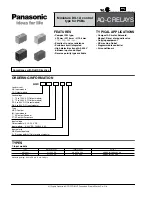
7SG164 Ohmega 400 Series Impedance Functions
1.2 Quadrilateral Characteristic
In addition to MHO characteristics, some models of the relay have the option of quadrilateral
characteristics for earth fault coverage. The quadrilateral characteristic can be set according to
resistive coverage, reactive coverage and the line angle. The resistive cut off blinder is set to the same
angle as the line angle.
1.2.1 Cross-polarised Quadrilateral
A typical polarised quadrilateral characteristic, as would be used for Zones 1 and 2, and the reverse
looking Zone 4 is shown below. This characteristic is constructed using two directional characteristics
(hence the need for polarising), a reactance characteristic and a resistance characteristic.
Because of the polarising quantities, the directional lines will exhibit a shift toward the source during
unbalanced faults, ensuring operation for close up forward faults, and stability for close up reverse
faults.
A self-polarised directional characteristic is given by the vector equation
IZ F
≡
V
Dividing through by
I
gives
Z F
≡
Z
In other words, we compare the angle of the fault impedance with the angle of the forward replica
impedance, as shown below. If the two angles are within 90°, then the comparator operates.
In order to obtain more reliable operation for close up fault conditions, the directional characteristic is
polarised from a source other than the fault voltage, which will allow accurate determination of the fault
direction for close-up faults. The vector equation for the polarized characteristic is
IZF
≡
VP
The magnitude and angle of
VP
will depend on a combination of factors, but for unbalanced fault
conditions it will be related to the source impedance
ZS
. For convenience the vector equation is
ZF
≡
ZS
The characteristic is shown below.
©2010 Siemens Protection Devices Limited
Chapter 2 Page 10 of 21
















































